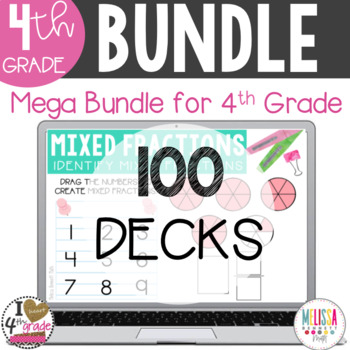4th Grade Boom Card Bundle
- Zip
- Internet Activities
What educators are saying
Products in this Bundle (75)
showing 1-5 of 75 products
Bonus
Description
*** This is a newly updated BOOM Bundle.
After purchase please click on the PDF Bonus file to download all 100 Boom Decks in one click. The new download includes Boom Decks not yet available in my Teachers Pay Teachers Store.
Looking for digital tools to implement into your classroom to increase motivation and improve student understanding? Boom Digital Task Cards are unique in the fact that they are like traditional task cards, but offer a self-checking feature. This 4th grade bundle contains 100 decks aligned to 4th grade standards. Use the decks on a variety of devices including: tablets, Starboards, and Chromebooks. All Boom Decks are hosted on the Boom Learning Website and are easily assessable on your Boom Library.
4th Grade NBT Standards:
Digital practice for reading and writing whole numbers, rounding whole numbers, multiplication using partial products and area models, division using partial quotients and area models.
4th Grade OA Standards:
Practice for identifying factors, multiples, prime and composite numbers, and understanding multiplicative comparisons.
4th Grade Fraction Standards:
Practice for all 4th grade fraction skills are included in this bundle.
4th Grade Measurement Standards:
Practice for understanding line plots, area and perimeter review, measuring angles on a protractor, and additive and decomposing angles.
4th Grade Geometry Standards
Practice for classifying and identifying angles in 2 dimensional figures.
** Click on the preview of each set to play the first 4 cards in each Boom Set.
MORE ABOUT BOOM DIGITAL TASK CARDS
"With your Teachers Pay Teachers purchase, users new to Boom Learning get a three-month free trial of student progress reporting for up to 150 students. Your trial includes the ability to make up to 5 free DIY decks. You may upgrade or cancel at any time. Boom Cards play on modern browsers (released in the last three years) on interactive whiteboards, computers and tablets. Boom Cards apps are also available. Not sure if your browser is modern enough? Try a free Boom Cards deck first. When you redeem your purchase, Boom Learning opens an account for you if you do not already have one. If you do not subscribe at the end of your trial, you will be able to continue using Boom Cards with the Fast Play feature. Fast Play does not track individual progress. If you do not subscribe we will delete your student records 3 months after the expiration of the trial to protect student privacy."


